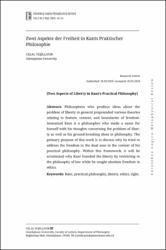Zwei Aspekte der Freiheit in Kants Praktischer Philosophie

View/
Access
CC0 1.0 Universalinfo:eu-repo/semantics/openAccesshttp://creativecommons.org/publicdomain/zero/1.0/Date
2018-05-30Access
CC0 1.0 Universalinfo:eu-repo/semantics/openAccesshttp://creativecommons.org/publicdomain/zero/1.0/Metadata
Show full item recordCitation
YEŞİLÇAYIR, CELAL. 2018. “Zwei Aspekte Der Freiheit in Kants Praktischer Philosophie.” EntelekyaLogico-Metaphysical Review 1 (1). EntelekyaLogico-Metaphysical Review: 41–54.Abstract
Philosophers who produce ideas about the problem of liberty in general propounded various theories relating to feature, content, and boundaries of freedom. Immanuel Kant is a philosopher who made a name for himself with his thoughts concerning the problem of liberty as well as his ground-breaking ideas in philosophy. The primary purpose of this work is to discuss why he tried to address the freedom in the dual axes in the context of his practical philosophy. Within this framework, it will be scrutinized why Kant founded the liberty by restricting in the philosophy of law while he sought absolute freedom in ethics.
Collections
The following license files are associated with this item:


















